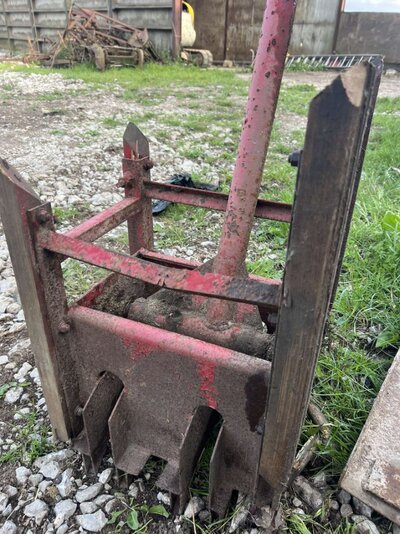You are using an out of date browser. It may not display this or other websites correctly.
You should upgrade or use an alternative browser.
You should upgrade or use an alternative browser.
Any ideas what this is?
- Thread starter s410man
- Start date
I thought little baler but couldn't quite figure out where it would goBaler ram
Would it be at the front of the chamber to the side of the pickup and the long arm would be what gathers the hay into wads?
The wooden posts on the corners also put me off thinking it was from a baler they look like they've always been on there!
julianthegypsy
Member
- Messages
- 4,302
- Location
- Cirencester
Plunger off a baler. The wood is like a wear plate that it slides on
julianthegypsy
Member
- Messages
- 4,302
- Location
- Cirencester
Plunger off a baler. The wooden bits are slides. Don't want metal to metal contact in a baler.
So that would be pushing front to back as such then to compress the bale rather than sideways across the baler?Plunger off a baler. The wooden bits are slides. Don't want metal to metal contact in a baler.
New holland colour paint I'm guessing?
wyn
Member
- Messages
- 3,728
- Location
- Cardiff
The long arm connects to a gearbox behind the flywheel.
The material gets picked up on the reel, fed side ways and the ram pushes it to the back and also has a knife on it that trims it every stroke.
The slots in the main bit allow the needles to travel up through the ram to the knotter.
paint could be massey or international.
I'm sure bearings were also used instead of wooden slides nearest to the pick up reel.
The material gets picked up on the reel, fed side ways and the ram pushes it to the back and also has a knife on it that trims it every stroke.
The slots in the main bit allow the needles to travel up through the ram to the knotter.
paint could be massey or international.
I'm sure bearings were also used instead of wooden slides nearest to the pick up reel.
julianthegypsy
Member
- Messages
- 4,302
- Location
- Cirencester
The masses had a bearing running on a trapezoidal rail, on the MF120 anyway. As I remember, you adjusted the rail to set the knife clearance but I could be imagining that. That one had suretie knitters using an epicylic gear too, very slick.The long arm connects to a gearbox behind the flywheel.
The material gets picked up on the reel, fed side ways and the ram pushes it to the back and also has a knife on it that trims it every stroke.
The slots in the main bit allow the needles to travel up through the ram to the knotter.
paint could be massey or international.
I'm sure bearings were also used instead of wooden slides nearest to the pick up reel.
wyn
Member
- Messages
- 3,728
- Location
- Cardiff
The masses had a bearing running on a trapezoidal rail, on the MF120 anyway. As I remember, you adjusted the rail to set the knife clearance but I could be imagining that. That one had suretie knitters using an epicylic gear too, very slick.
It was the 124's that I mostly worked on.
julianthegypsy
Member
- Messages
- 4,302
- Location
- Cirencester
Some makers used aluminium needles for the same reason.On a New Holland the feeding finger closest to the compactor was made of wood so that if the timing went out of sync it would cause minimal damage.
Erie Fred
Member
- Messages
- 5,888
- Location
- Erie, Pa USofA
Long story......about 20 years ago, my neighbor farmer (dairy) had a very new NH small square baler with the thrower etc. IIRC about $30k.
Other neighbor borrowed it to bale for some horses, and was bringing it back when i drove by.
so, being helpfull, I stopped to unhook it for him (so he could stay up in the cab).
It was a calm evening, sun just starting down, dead calm.
Farmer is out there leaning on the baler, borrow-er shut down and was also
standing near the chamber (farmer was on the pick up side) and I'm still up at the hitch & PTO shaft.
As they are talking I see the slightest wiff of smoke going straight up from the chamber...like a freshly blown out candle in a still room....
They didn't see nor smell it.
I yelled FIRE and jumped over the hitch to the chamber.
The one guy starts frantically pulling loose hay from the front of the plunger and let out a Ow, as he found the smoldering hay.
Could have been a total loss.
Other neighbor borrowed it to bale for some horses, and was bringing it back when i drove by.
so, being helpfull, I stopped to unhook it for him (so he could stay up in the cab).
It was a calm evening, sun just starting down, dead calm.
Farmer is out there leaning on the baler, borrow-er shut down and was also
standing near the chamber (farmer was on the pick up side) and I'm still up at the hitch & PTO shaft.
As they are talking I see the slightest wiff of smoke going straight up from the chamber...like a freshly blown out candle in a still room....
They didn't see nor smell it.
I yelled FIRE and jumped over the hitch to the chamber.
The one guy starts frantically pulling loose hay from the front of the plunger and let out a Ow, as he found the smoldering hay.
Could have been a total loss.








